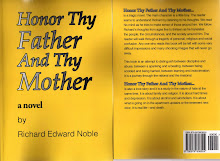Saturday, January 28, 2012
Cat Point and Them Dang Oyster People
B o o k s 4 T o m o r r o w: QUICK REVIEW: "Cat Point and Them Dang Oyster Peop...: “ CAT POINT AND THEM DANG OYSTER PEOPLE ” by Richard Edward Noble REVIEWED BY : David Fritz OVERVIEW In 1976 my wife and ...
Saturday, January 21, 2012

If you are interested in Mr. Watson's book "Mills, Migrants, and the American Dream," you may also find my book, "America on Strike" of equal interest. Thanks.
Bruce Watson
Mills, Migrants, and the American Dream
Bread and Roses - 1912
By Richard E. Noble
My discovery of the Bread and Roses Strike of 1912 in Lawrence, Massachusetts has provided me with an extremely interesting source of intellectual and personal insight.
Although I was born in Baltimore, Maryland my life from a few months old to age 27 was spent in Lawrence, Mass. My father and my mother were ex-mill workers - as were their fathers and mothers. My father was from the established English heritage and my mother descended from the later Eastern European migration. She was Polish.
I only worked briefly as did my older brother in a reconstituted worked-over enterprise that rented old mill space after the mills were abandoned by their textile owners. But even though I never worked in a textile mill, those mills played an ominous and hauntingly important part in my life.
The original mills were the reason for being for the city of Lawrence. First God built the mills and then he sent the people to work them. The mills came first and the people came second - and that is the history of the mills of Lawrence - and maybe mill towns all over America. And it is always interesting to me that when it was all over what was left was row upon row of empty red brick pyramids and mile after mile of drained sapped people and landscape. It was like a war zone where the weapon of choice was not explosives but a psychological sort of Neutron bomb.
Fighting for the jobs and positions at the mills basically determined the social status of the populous. From the 1840s to the 1950s the mills were the heart and soul and supplied the bread and the few roses that might have been scattered here and there throughout the city.
From approximately the time of my birth forward the mills were on a steady decline and by the end of World War II the mills had for the most part abandoned Lawrence. Unemployment through the late forties and onward through the fifties rose to over forty percent. That was a number that I had been seeking for quite some time. The 1929 Depression was only 30% unemployment. I knew the situation was serious because my dad was one of that 40%, but as is always the case - even with 40% unemployed, 60%still had a job. That 60% living at the time knew only too well how lucky they were, but their descendants have long since forgotten – or were never even made aware of the hardship of their neighbors. I found that 40% figure in this book by Mr. Watson.
Another question that had perplexed me is why I had never heard of this strike; why I had never seen any monuments in the city parks; why my parents and relatives never spoke of it; why the Nuns in grade school never mentioned such an event even in passing; why the Brothers didn’t teach it in high school; and the bigger question why the history books ignored the American labor movement almost entirely.
I first got interested in this subject matter by discovering, quite by accident, the Bread and Roses Strike. Researching this strike then led me to the labor movement in the U.S. and then in the world.
For me making this discovery was like finding the missing link or the lost piece of the puzzle. I truly feel now that understanding labor history or the history of the labor movement is the Rosetta Stone for interpreting our modern civilization. This is where our modern history begins - and this period in man’s evolution has not come to an end yet. It is the latest episode in a long continuous battle for freedom, dignity and equality.
Mr. Watson explains in his Epilogue that the history of the Lawrence Bread and Roses Strike was suppressed in the area because it had been a brand of shame for the city as a whole throughout the entire U.S. and throughout the world. Lawrence became a poster child for how not to handle a mill strike and how not to treat new immigrants, working women and children in America. The City (establishment) of Lawrence had been disgraced and shamed and they then proceeded to propagandize a “cover” story or a rationalization to hide and cover over what they had done and what had actually happened. And it worked because all that remained for the rest of the century was their version of the event. It is only until recently that the whole truth of the matter has been seeping out.
It seems to me that this is basically the same story with regards to the American Labor Movement. And the truth about it is also beginning to seep out.
Just as the Germans have been the last to admit the horror of the holocaust and the Japanese the last to accept the Rape of Nanking and their other World War II atrocities, America will be the last to admit its persecution of the working class and the working poor. America hates poverty - and it hates to accept or admit the fact of it even more.
America is filled with poverty, slums and industrial blight and it seems that it always has been - but yet most Americans will deny its very existence - and so it goes on and on and on.
Reading this book was more than a history lesson for me. Since I was raised in the area, every street name brought back an old memory; all the family names brought back friends and neighbors; and the stories brought back reason and insight into many personal mysteries.
I really enjoyed this book and I’m happy Mr. Watson wrote it. I will add it to my collection of Lawrence memorabilia and labor union history.
I am left with the desire to read more about Lawrence and I know from other reading that there is a lot more to read. Every open door leads to another door yet to be opened.
Very surprising to me is the discovery that at Cornell University there is actually a school of Industrial and Labor Relations that offers a four year degree in labor studies. It was started in 1945 and is the only college in the United States offering such a degree. I intend to do a good deal of reading and learning at their web site. It should be fun.
Bread and Roses by Bruce Watson is a great read for anyone interested in history in general, and the Labor Movement in particular. This book should be required reading in every high school in the Greater Lawrence area - but I have no doubt that it is not and will not be in the future.
Monday, January 16, 2012


If you like Mr. Grieder's book, "Who will Tell the People" you might also enjoy "America on Strike" or "Mein Kampf - An Analysis of Book One" both books are written by Richard Edward Noble. Thanks.
Who Will Tell the People?
Book Review
By Richard E. Noble
I have been educating myself for over forty years now. I have chosen many great professors to help me along my path to understanding, but I won’t get into that at this moment, other than to tell you about my most recent selection as professor of Civics.
In high school I had a course called Civics. I never figured out exactly what the word “Civics” meant, but I interpret the word as encompassing an explanation of the society and world currently happening around me – politically, socially, economically.
In my high school Civics class we read the daily newspapers, random magazines, and kept up on the local government issues, among other things.
In trying to understanding the modern day world –governments, societies, and general direction of the civilization – I found myself very confused. I wanted to find a professor who could get me up to speed on what is really going on in the world around me. As you know one must choose selectively because there are “so many books and so little time.” Consequently I have chosen William Greider as my “Civics” professor.
I have finished my third book by William Greider this morning, “Who Will Tell the People.” I thought that to be a wonderful title for a book. I have been asking myself that same questions on many different subjects for many years. If you have also been wondering “Who Will Tell the People,” I think I can tell you quite sincerely that one of the people who will tell the people is certainly William Greider.
It is so rewarding when you find an honest, straightforward voice in this world of obfuscation and – for lack of a better word – pure bullshit.
On Mr. Greider’s web site he calls himself an old journalistic type – but Mr. Greider is much more than a Journalist. He is an educator; he is a teacher, an instructor; he is a professor. He has his Doctorate in personal experience in the affairs of the world – that becomes obvious as you follow along behind him.
In Who Will Tell the People we learn, among many other things, how our Democracy works ... or doesn’t work.
Mr. Greider tells us how the Democracy we think we have, lines up to the Democracy we really have.
He tells us about how the laws are made and then un-made. He tells us about the lobbyists, and the lawyers and the Democrats and the Republicans and the Repubocrats – and who owns each of them.
He tells us about the money, the big businesses, the banks, the international conglomerates.
He tells us about the environment; about the military and the pentagon; about who’s in, and who’s out, and why.
At various points in reading Mr. Greider I say to myself – This guy is giving me more than I really want to know. I mean the more I know, the worse it gets. But then he throws in a suggestion, an idea, a possible solution and once again I’m thinking positively.
I am basically a skeptic and I think of the “Power of Positive Thinking” as a prescription for dilution. But you have got to have some kind of hope, even if it is farfetched, distant and on the borders of impossibility. There must be something!
Mr. Greider brings us to the brink, then pushes us off.
Then half-way down, falling into the abyss of eternal despair, we find there is a bungee cord wrapped around our waist. It isn’t much, and the discovery is a little late and maybe not totally reassuring, but it helps.
This book was published in 1992, when we were beginning to talk of “peace dividends” and cutting back on the Military Industrial Complex. Listen to what Mr. Greider was saying way back then:
“The Defense Department was planning a modest five year reduction in the Cold War mobilization ... If the U.S. defense budget were cut in half, it would still be four or five times larger than that of the next strongest nation ... The next round of demobilization would be for real: bringing home troops that had been stationed abroad since the 1950s, closing scores of domestic military bases, shutting more factories ... A few liberals introduced “conversion” bills that did little more than encourage communities and industries to plan for their post-Cold War future. Conservative thinkers concentrated meanwhile, on trying to devise substitute “threats” – Third World terrorism or nuclear proliferation – that might justify continuing the nation’s permanent war footing.”
Chapter 15 of this book is entitled “Citizen GE.” This chapter alone is worth the entire price of the book.
My tendency is to tell you myself what Mr. Greider has to say, but I couldn’t tell the tale as well or with any greater poignancy. I can only tell you to get the book and read it for yourself.
It is not that GE is any worse or better than any of the others; it is more shocking to understand that they are just one of a bunch of like-acting and similar thinking Mega-mights.
If I wanted to continue quoting from this book, this review would be one hundred pages long.
My advice is to buy Mr. Greider’s books and study them. That’s what I’m doing. I’ve only read three thus far, but I know that I am already a world ahead of where I was less than a year ago. Mr. Greider is more than “a read.” He is an education. I feel so lucky to have found such a treasure.
Monday, January 09, 2012
Collision Course

Collision Course
Ronald Reagan
The Traffic Controllers
And the strike that Changed America
By Joseph A. McCartin
Book Review
By Richard Edward Noble
I would guess that this is the most definitive history of the Traffic Controllers’ Strike yet to be written. Knowing what I know of American Labor History, it will probably be the only History of the Traffic Controllers’ Strike of 1981 that will ever be written.
I commend Mr. Joseph A. McCartin for performing this thankless and laborious task. Since I have become somewhat of a Labor history buff in recent years, this book will be added to my reference library along side the many others that I have been collecting for the last several years.
The history of American Labor problems in America is extremely limited and information difficult to find. The Reagan administration’s discontinuance of government statistical strike data will guarantee the difficulty of that task in future years.
I wrote my own book on the subject. It is entitled “America on Strike” and it is a survey of many prominent Labor strikes throughout American History. It begins in the Colonial period and ends with Ronald Reagan and the Traffic Controllers’ Strike. I ended my book with the Traffic Controllers’ Strike because like this author I figured it to be a big historical confrontation and devastating to the American Labor Movement.
My synopsis of the strike is a mere five pages long. I couldn’t find very much information on the Controllers’ Strike when I was putting my book together so when I saw this book, I jumped on it.
The author covers the formation of the PATCO union or association from its start in 1968 until it disintegration in 1981.
The book is thorough and informative. It is written from an inside the union perspective as opposed to an inside the Reagan administration perspective.
I couldn’t have asked for a more in depth analysis.
The history of the union and its leaders is covered intimately while all the while a focus is kept on the big confrontation with Ronald Reagan and his radical rightwing cohorts.
I will restrain myself from criticizing or picking arguments with the author other than to say, I feel he was a bit too kind and overly understanding of President Reagan and his administration.
That the president was hypocritical in his position against PATCO I consider a given.
That the goal of his administration was union busting is also a given. It is the confirmed historical position of the Republican Party and it cannot be denied in my opinion.
That the union was justified in all of its early positions is and has been substantiated.
The fact that the scabs who replaced the 15,000 fired workers no sooner got settled in than they formed their own union and petitioned the government with the exact same complaints the leaders of the PATCO union had presented, says it all.
Like his hero, Calvin Coolidge, the Reagan administration acted politically and not for the interest of his country. Coolidge and Reagan both benefited from their immoral political shenanigans quite favorably while the country suffered immensely – especially so with the Reagan fiasco.
Reagan used taxpayer dollars to fight tax paying workers in this flagrant union busting action. This cost the American people not just millions … but billions.
His use of replacement scab labor revived a horror from the past that if pursued by the Controllers in the traditional labor management format could have resulted in the loss of many lives.
An historical “gentleman’s” agreement had been set in place with regards to this issue. Reagan, in defying this understanding proved himself to be no gentleman and opened a kettle of worms that could and may ignite still glowing embers of acute bitterness in the historical oven of a seriously violent past. Be forewarned, this could mean the start of something BAD.
The Boston Police strike and President Coolidge’s stand remain a national historical disgrace.
Reagan and his posturing will be added to that historical disgrace, I have no doubt.
So other than the author somewhat leaning over backward in his analysis of the Reagan administration, I enjoyed the book immensely.
Mr. McCartin’s analysis on what could have been done by the union to possibly guarantee a successful outcome is thought provoking, thorough and should be read by all union activists and organizers still pursuing that difficult and heroic task today.
This is a very well written and extremely informative Labor history book. I highly recommend it.
Subscribe to:
Posts (Atom)






































